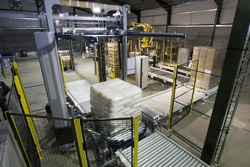
Posted to News on 7th May 2015, 16:24
Filling pallets - it's not always as easy as it looks!
If you are currently stacking pallets by hand, have you analysed the manual handling aspects of the people performing this vital function? How high can they reach (safely), how many times do they have to twist, how heavy is each case or sack - is the finished stack ideal for transportation? Paul Wilkinson, Business Development Manager, Pacepacker Services, discusses optimising palletisation.

It might seem like a giant game of Jenga, only slightly less fun, but working out how to optimise your palletisation could add significantly to your bottom line, saving transport costs and labour, as well as H&S issues. Although there are many different patterns most can be automated with a robot.
Pallet filling aims are twofold: firstly to get as much product onto the pallet as possible within the appropriate weight and height limits to maximise efficiency, and secondly to create as stable a unit as possible to protect your products during the distribution process and to avoid potentially dangerous or costly movement of goods in transit. Outside of these primary aims, other factors to consider are bar code scanning or the ease of picking or de-packing the stack by the customer.
In terms of format, the first consideration may be one you have no control over: pallet type and size. The most common standard pallet remains the 1 × 1.2m pallet, but there are even variations within this. Do the straps run parallel to the long or short edge? Are all four sides fitted with skid bases and is the pallet configured for 4-way or 2-way entry?
If we assume we are stacking a standard 4-way 1 × 1.2m pallet, with a common stacking/nesting plastic crate (600 × 400 × 167mm), then a typical stack will have five units per row, stacked up to 10 high, depending on specification and weight. The way that the crates interlock prevents stacking them in a pattern which would overlap the layers. However, if using rigid cardboard boxes of similar size, mirroring each row as you build the stack can increase rigidity of the overall pallet.
While these trays would allow you to put up to 50 on a 1.8m high standard pallet, a smaller 0.8 × 1.2m Euro pallet will only accommodate 40, and the narrower width may mean you want to reduce the overall height, further reducing the capacity of each pallet. In other situations certain pallets may not be suitable. For example, a 300 × 235mm cardboard box fits evenly onto a 1 × 1.2 m pallet with 16 per layer, but the 13-per-layer configuration possible on the Euro pallet leaves an uneven gap.
Tricky products can cause problems. Sacks tend to be lumpy compared with plastic crates or cardboard boxes and plastic ones may be more slippery than paper. In many cases a person building a pallet can compensate for slight variations in outer package shape and pallet stability, but strong pallet binding with wrap or strapping may be required to avert potential disaster. Palletising location and climate can also have an effect such as stacking bags of frozen product where condensation can form making slippery sacks and packs.
Although there are many free pallet load calculators available on the Internet, but for non-standard pack sizes we would always recommend seeking expert advice. At Pacepacker's Essex-based site, an award-winning purpose-built "Try Before You Buy' facility enables customers to complete pallet stack trials, giving them 100 per cent confidence in their palletising technique. The company's handling and packaging specialists have a wealth of experience to draw on and advise the best way to make your palletising operation as efficient as possible.
To learn more about optimising palletisation please visit www.pacepacker.com.
Want the latest machine building news straight to your inbox? Become a MachineBuilding member for free today >>
X
X
GLOBAL

















